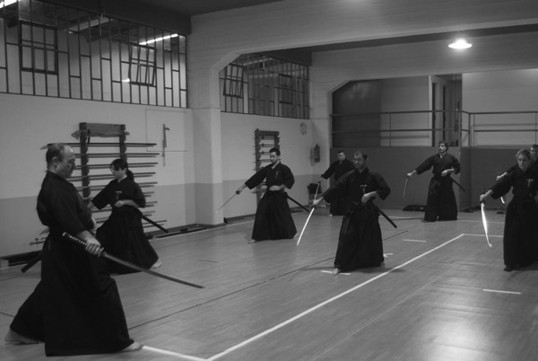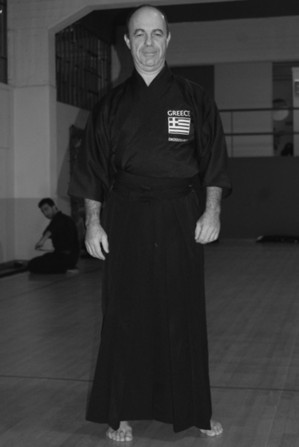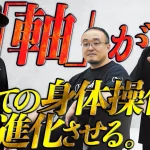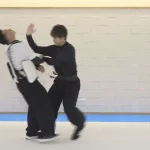text by Grigoris A.Miliaresis
It’s the dawn of the New Year’s Day in Athens and the traffic is scarce; mostly people dressed in their best clothes and returning from some New Year’s Eve party. But if you happen across a small street in the northern suburb Neo Irakleio, the picture is a little different. People get off parked cars and exchange wishes but they are also carrying gym bags and sword cases. Even though the weather about 5C (Athens is in the same latitude with Niigata!) and some of them haven’t yet, they’ve been coming here every New Year’s Day for the last ten years so they can participate in hatsunuki, the first iaido training of the year. The building they are parking their cars next to, looks like an old warehouse but it is actually a martial arts school hosting Furyu Iaido and Kendo Dojo.

The space, which belongs to a martial arts club specializing in aikido, judo and systema is big enough to hold one regulation-sized judo tatami and a big parquet floor for arts that don’t involve falls. Furyu Dojo rents it three-times-a-week for two sessions of kendo and one session of iaido; it can’t have a fixed space because of its size: with 75 registered members, 20 of whom are attending regularly (iaido, kendo or both) and more being added every year, it’s very hard to find a permanent space big enough to accommodate all of them and at a reasonable price.
The price needs to be reasonable because Furyu has one more peculiarity: the iaido and kendo teachers are not getting paid. The fee the members pay goes either to the rent of the training space or to a fund which is used for the organization of seminars, for supporting the participation in tournaments or for when times aren’t financially stable –like they are now in Greece.

This year, only ten members attend the hatsunuki; their enthusiasm hasn’t waned, though. They have come to greet the New Year with their swords and to show their teacher that if he is willing to leave the warmth of his home, so are they. For this to make more sense, one needs to meet Furyu’s dojo-cho, retired vice-admiral Spyros Drosoulakis, a veteran of the Japanese martial arts (an iaido 4 dan, kendo 2 dan and Shotokan karate 4 dan). Even in a casual talk, his passion for the martial arts is contagious.

“I know few people would think of leaving their homes at this particular hour of this particular day. But I believe the hatsunuki is important because it allows people to make a statement to themselves and to their dojo community. I never discriminated the dojo members on the basis of who comes to the hatsunuki and who doesn’t and I never will, but we’ve always had at least ten members joining. It’s a bonding event and a dojo needs such events even though the main bonding event is the practice itself”.

And indeed it is: in the 10 years of Furyu’s existence, admiral Drosoulakis has seen its membership rise from 6 to 75, its arts double (first it was iaido, now iaido and kendo) and its members passing dan examinations before both European and Japanese boards in Greece and abroad. Furthermore, the dojo’s chief instructor and supervisor is one of the top Japanese teachers in the modern sword arts: Oda Katsuo from Shizuoka, iaido 8 dan hanshi/kendo 7 dan kyoshi. Oda sensei has been visiting Greece at least twice a year since 2005 and is responsible for Furyu’s advancement.
Being also the Greek Kendo-Iaido-Naginata Federation’s Secretary, admiral Drosoulakis has seen from up close the struggle the few hundred dedicated practitioners have been going through for the last decade: lack of certified teachers, unavailability of equipment, scarcity of training spaces and the general public’s ignorance or indifference have been the major stumbling blocks. But the members of Furyu, together with the members of seventeen more dojo in Athens and all over Greece (all belonging to the Federation) are resolute to continue their training at any cost; if this means ordering their bogu and swords from the Internet (since there are no stores selling this kind of equipment in Greece), never being certain about what they are ordering and when it will arrive and travelling abroad for seminars and examinations, so be it

Related article:24th Budo Culture Seminar: Educational power of budo Part.2
 About the author
About the author
Grigoris Miliaresis has been practicing Japanese martial arts since 1986. He has dan grades in judo, aikido and iaido and has translated in Greek over 30 martial arts’ books including Jigoro Kano’s “Kodokan Judo”, Yagyu Munenori’s “The Life-Giving Sword”, Miyamoto Musashi’s “Book of Five Rings”, Takuan Shoho’s “The Unfettered Mind” and Donn Draeger’s “Martial Arts and Ways of Japan” trilogy. Since 2007 his practice has been exclusively in classic schools: Tenshin Buko-ryu Heiho under Ellis Amdur in Greece and Kent Sorensen in Japan and, since 2016, Ono-ha Itto-ryu under 17th headmaster Sasamori Takemi and 18th headmaster Yabuki Yuji.
http://about.me/grigorismiliaresis














